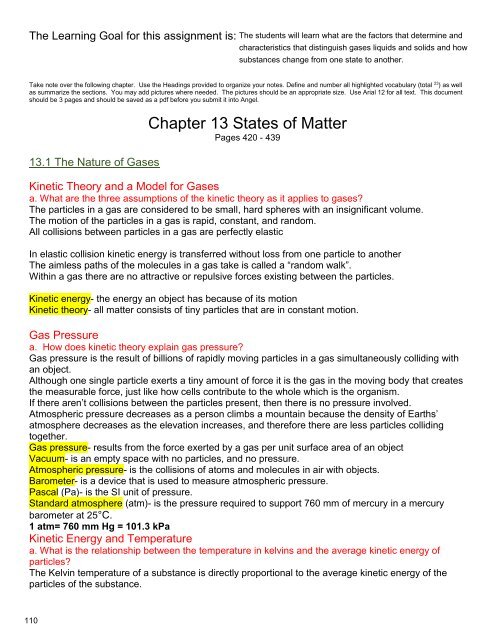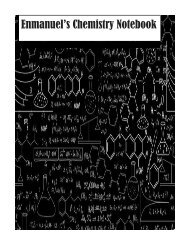Create successful ePaper yourself
Turn your PDF publications into a flip-book with our unique Google optimized e-Paper software.
The Learning Goal for this assignment is:<br />
Take note over the following chapter. Use the Headings provided to organize your notes. Define and number all highlighted vocabulary (total 23 ) as well<br />
as summarize the sections. You may add pictures where needed. The pictures should be an appropriate size. Use Arial 12 for all text. This document<br />
should be 3 pages and should be saved as a pdf before you submit it into Angel.<br />
13.1 The Nature of Gases<br />
Chapter 13 States of Matter<br />
Pages 420 - 439<br />
Kinetic Theory and a Model for Gases<br />
a. What are the three assumptions of the kinetic theory as it applies to gases?<br />
The particles in a gas are considered to be small, hard spheres with an insignificant volume.<br />
The motion of the particles in a gas is rapid, constant, and random.<br />
All collisions between particles in a gas are perfectly elastic<br />
In elastic collision kinetic energy is transferred without loss from one particle to another<br />
The aimless paths of the molecules in a gas take is called a “random walk”.<br />
Within a gas there are no attractive or repulsive forces existing between the particles.<br />
Kinetic energy- the energy an object has because of its motion<br />
Kinetic theory- all matter consists of tiny particles that are in constant motion.<br />
Gas Pressure<br />
a. How does kinetic theory explain gas pressure?<br />
Gas pressure is the result of billions of rapidly moving particles in a gas simultaneously colliding with<br />
an object.<br />
Although one single particle exerts a tiny amount of force it is the gas in the moving body that creates<br />
the measurable force, just like how cells contribute to the whole which is the organism.<br />
If there aren’t collisions between the particles present, then there is no pressure involved.<br />
Atmospheric pressure decreases as a person climbs a mountain because the density of Earths’<br />
atmosphere decreases as the elevation increases, and therefore there are less particles colliding<br />
together.<br />
Gas pressure- results from the force exerted by a gas per unit surface area of an object<br />
Vacuum- is an empty space with no particles, and no pressure.<br />
Atmospheric pressure- is the collisions of atoms and molecules in air with objects.<br />
Barometer- is a device that is used to measure atmospheric pressure.<br />
Pascal (Pa)- is the SI unit of pressure.<br />
Standard atmosphere (atm)- is the pressure required to support 760 mm of mercury in a mercury<br />
barometer at 25°C.<br />
1 atm= 760 mm Hg = 101.3 kPa<br />
Kinetic Energy and Temperature<br />
a. What is the relationship between the temperature in kelvins and the average kinetic energy of<br />
particles?<br />
The Kelvin temperature of a substance is directly proportional to the average kinetic energy of the<br />
particles of the substance.




